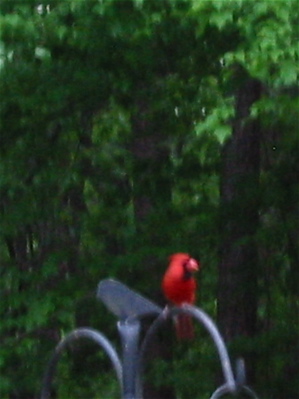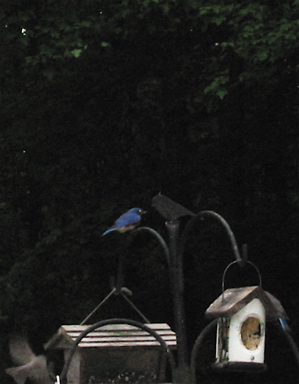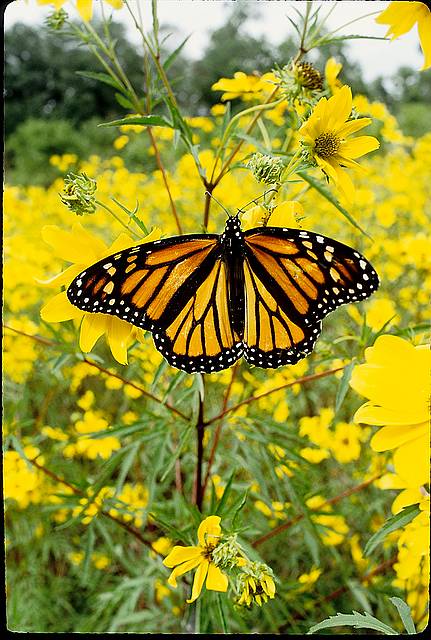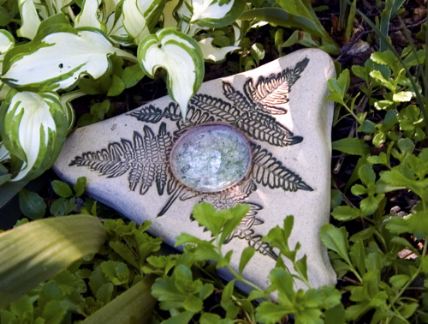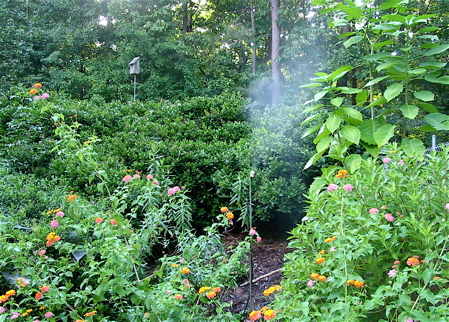-
a great perching spot on bird feeder pole
Because I lack any really decent photography equipment, the image isn’t so great, in fact I was pretending to digiscope with a pair of cheap binoculars. But that’s not the point of this blog. The bird feeder pole where this cardinal is perched sees a whole lot of activity in our back yard. From bluebirds and chickadees to titmice and woodpeckers, the four-arm bird feeder pole offers the perfect perching spot to rest and hunt.
Recently we had a semi-successful brood of bluebirds. Five babies made it out into the world, but the task of raising all five alone must have been too much for mom. Three days before these babies fledged, dad went missing. Perhaps the red-tailed hawk who hangs around, or my neighbor’s pain in the $#@ cats had gotten to him? Although I’ll never know his fate, he did leave his legacy in the three thriving juveniles. They like landing on this bird feeder pole because the mealworm dish is attached to it. They have options where to land and perch, and because the pole’s arms are at two levels, the babies can ease their way down to the dish. New males are in the area, but they’re not so kind to the babies, Mother Nature sure can be brutal at times 🙁
So here’s another pretty bad photo of dad bluebird before he disappeared, perched on the same bird feeder pole
. It’s really stinks not having a decent camera because the birds in our yard are many and varied. There’s an Eastern Phoebe feeding two babies, three kinds of woodpeckers, all the usual suspects, and a thrasher who hangs around. Now, if the darn starlings would just hit the road… all would be well.
-
check out this fascinating chimp video from National Geographic.
Two years ago, a moving photograph taken by National Geographic went viral – appearing on television shows and newspapers throughout the world.. It depicted a group of chimps “mourning” a deceased member of their family. Earlier this morning, National Geographic released a video depicting a similar situation, where several chimps react to the passing of a nine-year-old.
The experts presenting the video tread softly when calling the chimps’ behavior “mourning,” as they are still in the process of determining whether or not chimpanzees are capable of such an emotional reaction.
-
use butterfly feeders along with leaf misters
Enticing butterflies has become a huge past-time for many gardeners and backyard birders alike. Earning nicknames like “flying flowers” and “winged jewels” these graceful beings bring joy and delight to many with their sheer presence. But what really works to bring butterflies to your place? There’s butterfly houses, and butterfly feeders, and butterfly baths, and puddlers too!
Although I’m no expert, during summer months you’ll find daily butterfly activity in our garden that’s pretty amazing. We have no butterfly house, nor do we use a feeder. The secret is a leaf mister and flowers which provide food in the form of nectar. Host plants are extremely important too – this is where butterflies lay their eggs. Host plants also provide a food source for the emerging caterpillar. Be forewarned though…heavy munching will occur on your host plants.
We see mostly Monarchs and Swallowtails, and Milkweed serves as the host plant. Lots of native shrubs and flowers entice butterflies and keep them around all season. Mature White Fringe Trees line the back yard, Service Berry shrubs sit in the front, Columbine, Trumpet Vine, Native Hibiscus, and Bottlebrush are just a few other plantings around the yard.
Butterflies do adore over-ripened fruit like bananas, oranges, melon and pears, but you must be sure the fruit does not mold. Butterfly puddlers are popular too, but it’s rare that they’ll drink from an open water source. Instead, the clay absorbs the water, and butterflies will sit upon the dampened clay surface. If using a but
terfly feeder, it should have a wick to absorb and draw up nectar from the basin, as butterflies will eat from the wick.
This season create a butterfly habitat by planting a few native species that will help them thrive and flourish. Add a leaf mister and you’ll see the increase in activity. If you build it… they will come!
Our summer butterfly habitat

